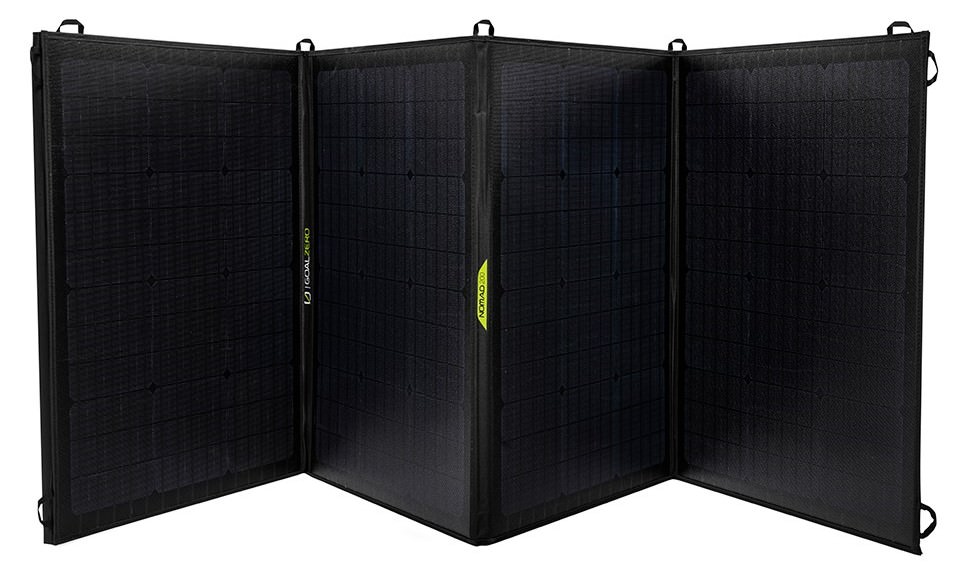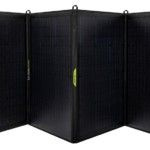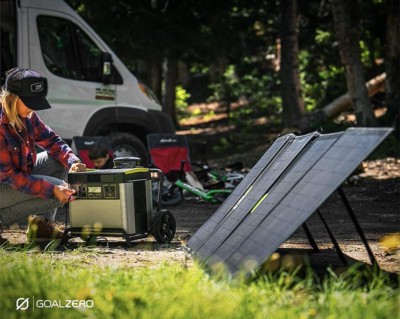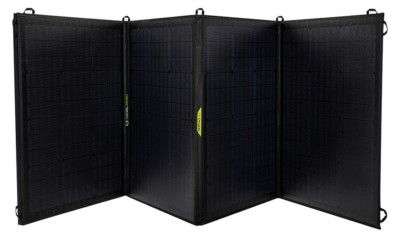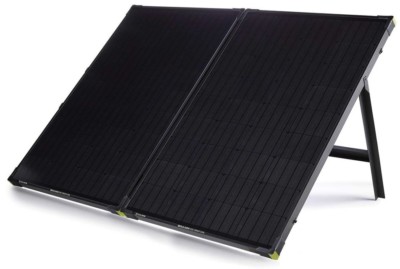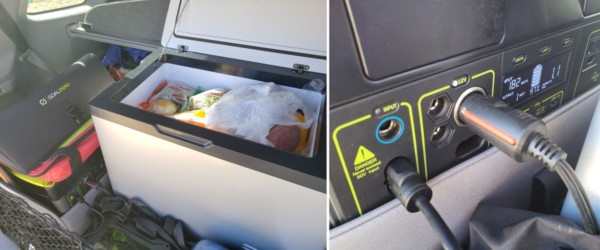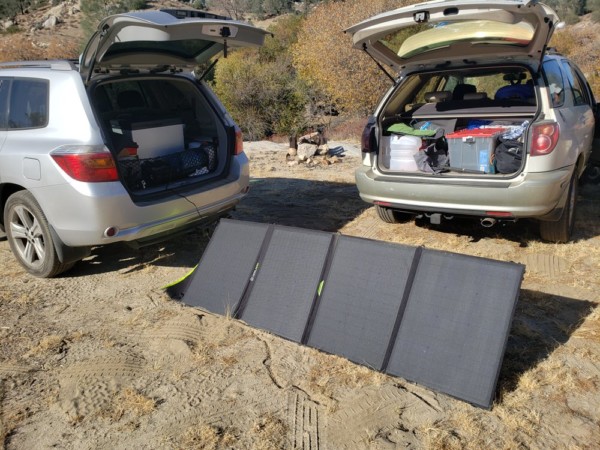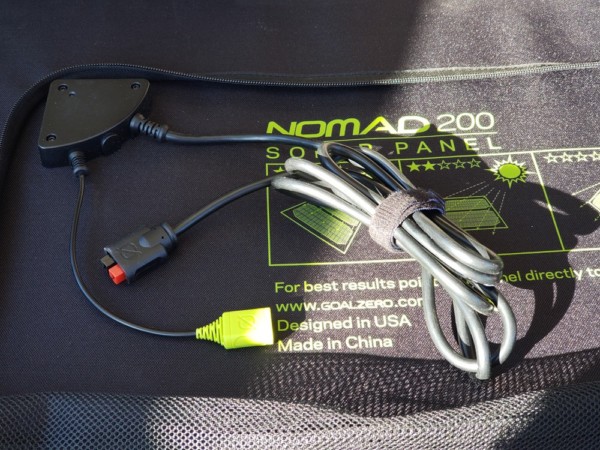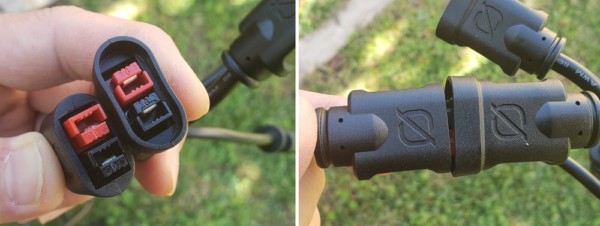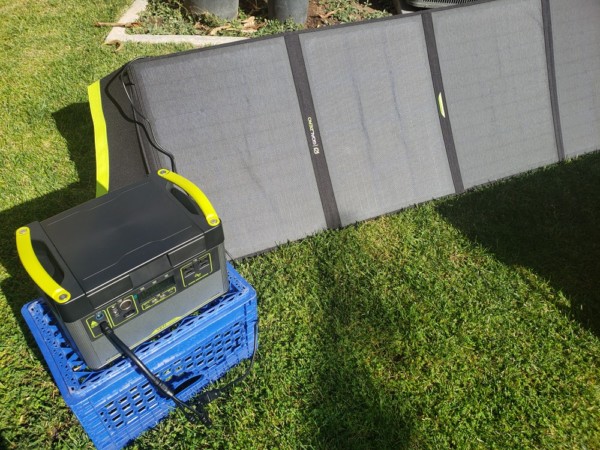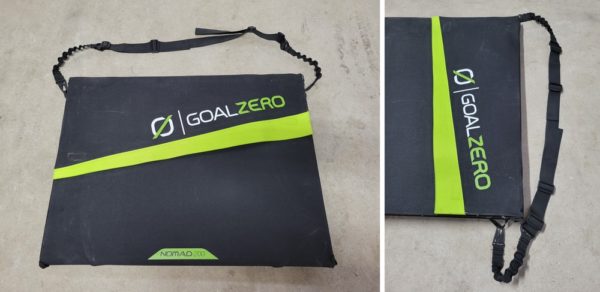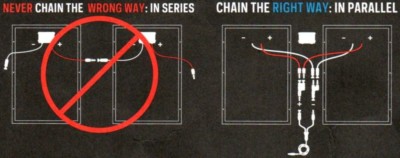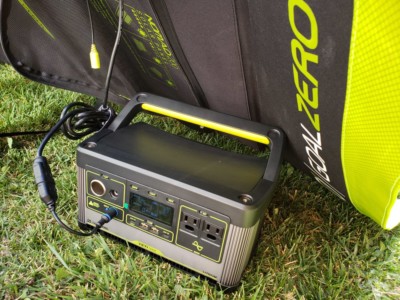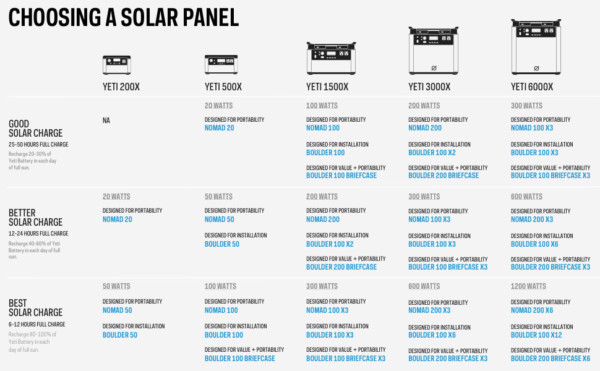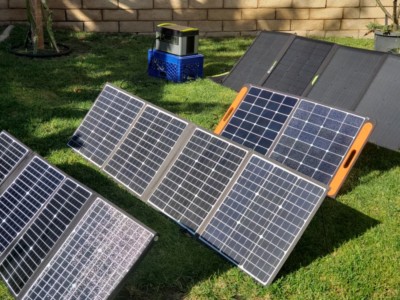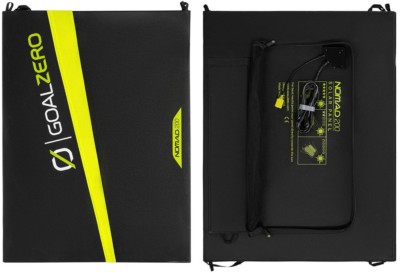Goal Zero Nomad 200 Foldable Solar Panel
Pros
- Surprisingly VERY efficient charging
- Foldable, space-saving design
- Large capacity in a single package
- Hanging and leg loops
- Built-in kickstands
Cons
- Heavy
- Flexible body could crack/break
- Slouches during initial unfolding
- APP cable not in common, horizontal orientation
- No USB-C port or cable
Contents
Large-Capacity Solar Charging
Solar panels are an excellent way to recharge batteries and subsequently provide power during outages, emergencies, or recreational activities. In fact, sales for gas generators, batteries, and solar panels had seen an uptick in demand. Our family even had to evacuate just 3 months ago when a wildfire ravaged nearby — life could suddenly get turned upside down in an instant!
My solar purchasing decisions have generally been around value, capacity, reliability, toughness, weight, size, and connectivity options. This time around, I got Goal Zero’s highest capacity, portable panel to charge my Yeti 1500x battery with: the foldable Nomad 200.
This review will not just go over the Pros and Cons of the Goal Zero Nomad 200, I also looked into how to make it work with products made by other manufacturers. Surprisingly, it did not take much to get them all to interoperate! (A more detailed article on how to connect different products with one another is planned in the near future.)
In A Nutshell
The Goal Zero Nomad 200 is a larger-capacity, 4-pane solar panel that folds down to a 1/4 of its full size. This makes it relatively compact, though at 22 lbs is not exactly lightweight. Where it stands out is its 200W of monocrystalline charging capacity, and when used in combination with other Nomads (or the company’s more rigid Boulder panels), quite a large amount of electricity can be produced to quickly charge a battery power station with, such as the Goal Zero Yeti 1500x that can take a whopping 600W!
Like monocrystalline solar panels by other manufacturers, however, expect to lose about 20-25% of efficiency from its stated 200W due to solar conversion, giving you a maximum output of roughly 160W per Nomad 200 on a perfect, sunny day. With that said, it charged at a surprising 162W – 182W (81-91% efficiency) during a November 2020 boondocking trip! This was likely due to the Yeti 1500x‘s MPPT (maximum power point tracker) controller that makes solar charging more effective. The Nomad 200 is priced the same as two Jackery SolarSaga 100W, and one may wonder: should you purchase a single product or two? That depends.
- Having two solar panels of 100W each (to get 200W) would allow one to still work if the other fails, though they would require more storage, extra cabling, and twice as long to set up and put away. With the Yeti 1500x battery accepting up to 600W from a maximum of 4 solar panels by default, they would fall short with a 400W (4 x 100W) output limit (or max 320W when taking loss from solar conversion into consideration).
- A single, 200W panel would result in faster setup, less space taken, and fewer of them needing to be connected to gain a larger amount of charging. The Yeti 1500x battery could receive its full 600W of input from the 800W a set of four, 200W panels would produce (max 640W when calculating for solar conversion efficiency). As such, there almost is no choice but to get the larger-capacity solar panel to be able to max out the Yeti X’s peak charging.
Nomad 200 has two output methods: USB and a vertically-arranged, 6′ Anderson Powerpole (APP). The latter allows the product to be used with any APP-compatible power station (such as the Jackery Explorer 1000), though you may need something like the iGreely APP Extension Cable to connect a standard, horizontally-arranged APP to Goal Zero’s vertical one.
Multiple loops can be found around the edges of the solar panel to accommodate a variety of mounting configurations like off the side of a truck or on rope. Built-in legs lean the panels at an optimal, 45-degree angle, though I prefer the more secure (but heavier), metal kickstands of the Suaoki 160W. Goal Zero does provide a stake-down loop for each leg as added fall protection, but I sometimes struggle with the initial unfolding of the Nomad on a sandy beach. Its flexible body would often cause part of the panel to fall over until all legs have been extended out. The legs and hang loops help keep the panels pointed optimally towards the sun.
Goal Zero also has the rigid, briefcase-style Boulder 200 solar panel that weighs 42 lbs. Its aluminum frame and tempered glass protection makes it more suitable for permanent/temporary installations (like on top of an RV or a mobile home) and costs less than the portable Nomad 200.
Overall, the ability to get up to an actual 170W of solar charging from a single product makes it portable and convenient, though its 22lb weight can feel a bit heavy to lug around. It took about the same space as the Jackery SolarSaga 100W. For charging a high-capacity battery like the Goal Zero Yeti 1500x, however, the Nomad 200 or Boulder 200 is an absolute must if you want to maximize its 600W input capability. A single Nomad 200 was more than enough to keep my Yeti 1500x fully charged while my wife and I worked from home with two laptops and external monitors.
Note: Goal Zero renamed its Anderson Powerpole (APP) ports in Nov 2020 to High Power Port (HPP) to avoid trademark infringement with its inventor: Anderson Power Products. This is only a name change as the connector works the same way as before. For the purpose of avoiding confusion, I will interchangeably refer to the port as HPP or APP.
What’s Good? What’s Bad?
Pros
- Monocrystalline solar panels provide VERY efficient charging at a consumer-friendly price point
- Most panels should expect between 70-80% charging of the stated wattage in near-perfect, sunny conditions
- In my testing on a sunny, California day in late November, I got between 162W – 182W, a VERY surprising 81-91% efficiency. That puts this panel right at the top
- High efficiency was likely due to Yeti 1500x‘s MPPT (maximum power point tracker) controller that makes solar charging more effective
- On another, cloudy, late-afternoon day, only 63W was produced
- Monocrystalline generally has a lifespan of 25-30 years, after which efficiency starts to drop
- Large-capacity solar charging of 200W in a single product negates the need to bring two 100W solar panels
- Can provide higher maximum charging output to compatible battery power stations
- Example: GZ Yeti 1500x power station can take 4 solar panels with a HPP-to-HPP 4x Combiner Cable
- Keeping in mind that there is a roughly 20% solar conversion efficiency loss and that Yeti 1500x can accept a maximum charging of 600W:
- (4) 200W panels = 640W (4 x 200W – 20%). Provides full 600W power to Yeti 1500x
- (4) 100W panels = 320W (4 x 100W – 20%). Does not maximize Yeti 1500x charging capability
- Keeping in mind that there is a roughly 20% solar conversion efficiency loss and that Yeti 1500x can accept a maximum charging of 600W:
- Example: GZ Yeti 1500x power station can take 4 solar panels with a HPP-to-HPP 4x Combiner Cable
- Saves on storage space to have a single product instead of two
- Faster to set up and put away than with multiple solar panels
- Can provide higher maximum charging output to compatible battery power stations
- Foldable design makes the panel portable/compact, easy to stow, and protected from dust
- Folded: 28.2″ H x 22.3″ L x 2.0″ D / Unfolded: 28.2″ H x 100.7″ L x 1.0″ D
- SolarSaga 100 — Folded: 22″ H x 24″ L x 1.8″ D / Unfolded: 22″ H x 48″ L x 0.9″ D
- Panels held together with two, medium-strength magnets for quick fold/unfold, though I preferred the Jackery SolarSaga 100’s stronger magnets
- Folded: 28.2″ H x 22.3″ L x 2.0″ D / Unfolded: 28.2″ H x 100.7″ L x 1.0″ D
Goal Zero Boulder 200: Rigid, briefcase-style solar panel that weighs 42 lbs. Aluminum frame, tempered glass protection, and bulkiness makes it suitable for permanent/temporary installations (like on RV or home) and costs less than the portable Nomad 200.
- Excellent pricing
- Costs the same as two Jackery SolarSaga 100 (to get 200W)
- Built-in kickstands to help prop the panels towards the sun at a 45 degree angle for optimal exposure
- Each leg has a loop to help stake it down
- Multiple loops around the edges accommodates a variety of mounting configurations
- Side of truck, along a rope, etc.
- Weight: 22 lbs
- Lighter than Goal Zero’s Boulder 200 (42 lbs) panels
- Heavier than TWO (to get 200W) Jackery SolarSaga 100 (5.5 lbs each)
- Output Ports
- (1) USB-A: 5V @ 2.4A (12W max) port for directly charging mobile devices and accessories, such as tablets
- (1) Anderson PowerPole (APP): 14-23V @ 14A (200W max)
- 6′ cable length
- Snaps securely to other Goal Zero accessories to minimize accidental disconnects and provide a degree of weather-proofing
- LED light to indicate charging status
- Contained within a built-in, zippered mesh pouch
- Daisy-chainable
- Multiple Nomads (or GZ Boulders) can be linked together in PARALLEL (NOT in a SERIES) for even more output (See TIPS section)
Cons
- Sometimes frustrating to set up on sand (ie. beach)
- While trying to pull out all kickstands behind each of the 4 panels, part of the far end of the Nomad’s flexible body could slouch over and pick up sand that you will have to wipe off afterwards
- Common issue with foldable solar panels
- Anderson PowerPole (APP)/HPP port is arranged vertically when most of the solar panels from other brands connect horizontally
- I questioned this move as an attempt to upsell Goal Zero-exclusive cables, but then I realized that it may be to differentiate the vertical and horizontal APP ports found on Goal Zero’s battery stations: one for input and the other for output
- You can purchase a third-party APP extension cable (like iGreely) to freely switch the orientation for use with other brands’ products (a guide on how to do this will be written soon)
- Potentially a single point of failure
- Example: One 200W vs two 100W panels
- If the 200W fails, you are left with no solar charging. If one of the 100W fails, you still have the second to charge with
- Example: One 200W vs two 100W panels
- Weight: 22 lbs
- Heavier than (2) two Jackery SolarSaga 100 (5.5 lbs each) for the same 200W output
- Some might consider the Nomad 200 as too heavy
- Flexible body can potentially cause the panels to snap and break
- More expensive than:
- Lesser known brands, such as Rockpals/Paxcess and Suaoki
- Non-foldable, rigid panels like Goal Zero Boulder 200 and Renogy
- Warranty: 1 year
- 2 years for Goal Zero Boulder 200 and Jackery SolarSaga 100
- No built-in USB-C or USB-C PD (Power Delivery) charging port
- No built-in battery to store some of the charge generated by the panel
- You can either directly charge devices with the panel, charge a battery-based generator, or a battery power bank
- Not waterproof, though online reviews show IPX3-equivalent water resistance (See TIPS section)
- Mesh pocket where the USB and APP cables are found are NOT water resistant. Keep them dry!
Tips/Notes
- Panel lifespan: Panels generally die/become inefficient between 25-30 years
- They may last longer, but would produce less energy
- Solar panels work best outdoor under full sun exposure
- Although the panels will work under the shade or behind windows, charging efficiency is greatly diminished
- Panels will STILL charge under cloudy conditions. So, keep the panels out even if you do not see the sun
- Operating temperature range: 14F to 149F (-10C to 65C)
- ONLY the solar panels can (and should) be directly under the sun while charging a battery power station
- Keep the power station in the shade to prevent overheating
- ALL panels must be uncovered to generate a charge
- Do not completely cover one or more panels or the charging will stop
- To maintain solar efficiency, the panels should be kept clean
- Remove dust with a soft brush and wipe with a damp (NOT wet) cloth
- Any residue, such as tree sap, should be removed as soon as possible
- Although Goal Zero states the panels are NOT waterproof, online user anecdotes claim IPX3-equivalent water resistance. This translates to:
- Capable of taking water sprays of up to 60 degree angles or less
- Keep dry the mesh pocket area containing the USB and Anderson cables. They are NOT water resistant!
- Heavier rain can cause damage
- Keep panel away from water that spray at greater than 60 degree angles
- Keep panel away from low-pressure (or stronger) water jet spray
- Do not submerge the panel under water
- Panels will work longer if they are kept away from water altogether
- Do NOT bend the panels more than 30 degrees or risk breaking them!
- Keep the panels away from fire and heaters
- Consider attaching a strap to make it easier to carry heavy solar panels around, such as those for iSUPs or Rifles
Solar Panel – Warning
Some power stations can be charged with one or more solar panels. There are SOME PRECAUTIONS you must take to minimize battery damage and/or injury to life/property:
- Never exceed the maximum Voltage (V) or Amperage (A) of a power station’s charging port
- If you want to use 2+ solar panels to charge faster:
- Do not mix them with different V or A as the output might get reduced (less energy generated)
- Do not daisy-chain them in sequence/series as that can exceed the power station’s maximum V or A
- Always connect them in PARALLEL with a Y-branch or Combiner cable
Goal Zero has several cables available for parallel solar charging. Choose the one appropriate for your power station: 8mm-to-HPP 4x Combiner Cable or HPP-to-HPP 4x Combiner Cable. HPP is Goal Zero’s name for the Anderson APP port.
Calculations
The below calculations are rough ESTIMATES as conditions, battery and solar panel quality, and age can vary.
Battery storage capacity is measured in Wh (Watt-hours) and power output is in W (Watts).
Charge Time with Solar
- Calc: Hours to charge battery = Battery capacity (Wh) / (Panel Wattage x [0.5 or 0.75])
- In a perfect lab environment, solar panels charge at the listed wattage
- Expect to only receive 50-75% on a good, sunny day (ie. 75W – 113W for a 150W panel), depending on panel’s age, component quality, and weather
- 200W solar panel
- Goal Zero Yeti 1500x: As fast as 10.1 hours [1516 Wh / (200W x 0.75)]
- Goal Zero Yeti 500x: As fast as 3.4 hours [505 Wh / (200W x 0.75)]
- Jackery Explorer 1000: As fast as 6.7 hours [1000 Wh / (200W x 0.75)]
- Tips
- Keep charging even when overcast as the panels will STILL collect energy
- Underproduction: If a 200W panel is not making enough (ie. only 50W) due to bad conditions, adding extra ones (ie. two more 200W) can generate a higher, combined output (ie. 50W + 110W from the two panels = 160W total)
- Overproduction: If the panels make more (ie. 400W) than the maximum the power station charge port can take (ie. 120W), only the max (ie. 120W) will go through
- WARNING: do NOT connect panels sequentially or you may output too much voltage and fry the power station! Connect them in PARALLEL with a Y-Branch cable
Watts Used/Produced
- Calc: Watts used or produced by device = Voltage x Amperage
- Vacuum with 120V @ 9.5A uses 1,140W
- Solar panel with 12V @ 10A can produce up to 120W
Time to Charge Device
- Calc: Hours to charge device = Device’s battery capacity (Wh) / Input Wattage
- Laptop with 200Wh battery, 200W solar panel, and 75% solar conversion loss: As fast as 1.4 hrs [200 Wh / (200W x 0.75)]
Use With Other Brands
Recently, I wanted to find ways to use my existing investments with Goal Zero without having to spend a fortune. A more detailed article will be forthcoming, but here are some quick tips on how to get products from other brands to work.
Different Solar Panels
As long as the solar panels from different brands or wattage produce the same VOLTAGE, you will be able to safely use them together with Goal Zero Yeti X power stations and the appropriate Goal Zero 4x Combiner cable (8mm-to-HPP 4x or HPP-to-HPP 4x). The key here is to connect them in PARALLEL. If the panels are NOT the same voltage, then the panel with the highest volts will be used by the Yeti X. I was able to connect these four panels with the Yeti 1500x:
- Goal Zero Nomad 200 / Jackery SolarSaga 100W / Paxcess Rockman 120W / Suaoki 160W
On a cloudy November day, the input values were:
- 63W = Nomad only
- 212W = Nomad + SolarSaga
- 231W = Nomad + SolarSaga + Rockman
- 262W = Nomad + SolarSaga + Rockman + Suaoki
I expect the panels to produce significantly more during the summer (to as much as 430W combined).
Final Thoughts
The Jackery SolarSaga 100 solar panel previously impressed me with its rigid body, light weight, and quick deployment. However, there were times where I wanted my higher-capacity power stations (like the Goal Zero Yeti 1500x or Jackery Explorer 1000) to be charged more quickly for a variety of reasons. The solution: bring 2+ SolarSaga but that quickly became a pain to set up and put away each time. Furthermore, to fully maximize the Yeti 1500x’s maximum 600W charging capability with up to 4 solar panels, the 100W panels would not work. This is where larger-capacity ones like the Goal Zero Nomad 200 or Boulder 200 came into play. Four of them could provide the full 600W the Yeti 1500x could accept, charging it from empty in as little as 3.4 hours — about the amount of time our group with small children would take to finish lunch, pack up, and head out for adventures!
We took the Nomad 200 on our last boondocking trip, and setting up just one solar panel instead of two to get 162W – 182W of charging was like a breath of fresh air. The 81% and 91% efficiencies were likely the result of the panels’ quality components and the Yeti 1500x’s MPPT controller responsible for more effective solar charging. Equally important was how quickly it could be folded away AND it took about the same amount of space as a single, 100W Jackery SolarSaga 100.
Not everything was peachy, however. Setting it up on a sandy ground got me frustrated at times as the long, flexible body would slouch and dig into the dirt while I tried to get all 4 kickstands to extend. I would then have to come back and wipe the panels clean with a damp cloth to maximize solar capture. You also have to be careful about how you handle foldable panels: they could potentially crack if not grasped with care.
The vertically-arranged Anderson (APP/HPP) cable keeps the Nomad 200 from being used with most other brands’ power stations that have horizontally-oriented ports. However, that can be fixed with the iGreely APP Extension Cable by re-arranging one end to be vertical.
Overall, I was extremely impressed by the 81% – 91% solar charging efficiency the Nomad 200 provided to the Yeti 1500x, and even though most Goal Zero products are on the pricey side, it actually costs the same as two Jackery SolarSaga 100 panels. That’s just icing on the cake!
Where To Buy
- Goal Zero Products
- iGreely APP/HPP Extension Cable
- Other Solar Panels
- Suaoki 160W / Paxcess Rockman 120W / Renogy 200W
Related Posts
- Solar Panels: Jackery SolarSaga 100W / EcoFlow 220W Bifacial / Rockpals 80W
- Power Stations
- Comparison: Goal Zero Yeti 1000 (Core, X, Lithium) vs Jackery Explorer 1000
- Goal Zero Yeti 1500x / Yeti 1000x / Yeti 500x
- Jackery Explorer 1000 / Explorer 300
- BigBlue Cellpowa500 LiFePO4

